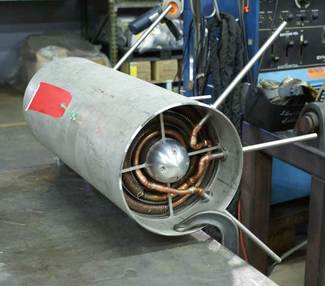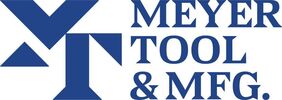Call: 708-425-9080
Case Study: Manufacture of a Helium/Hydrogen Heat Exchanger
 Assembly of Helium/Hydrogen Heat Exchanger
Assembly of Helium/Hydrogen Heat Exchanger
Invited by Roger Kellogg, P.E. to speak before the September 30th meeting of the Argonne Engineering Professionals, Mike Seely, PhD, Project Manager at Meyer Tool & Mfg., Inc. of Oak Lawn, Illinois, faced a luncheon crowd hungry for information on how ASME Boiler and Pressure Vessel Section VIII requirements can affect the design and construction of cryogenic pressure vessels.
This topic is of course of great interest to engineers at Argonne National Lab and the other DOE Laboratories as they grapple with the proper application of the ASME Code rules as they apply to the DOE directive to meet 10CFR 851 Appendix A Part 4 for all new pressure vessels and pressure piping.
Dr. Seely illustrated the intricacies of applying the Pressure Vessel Code to cryogenic vessels by presenting a “Case Study of a Helium/Hydrogen Heat Exchanger”. This case study was derived from a code stamped vessel recently designed and built by Meyer Tool for one of the national laboratories earlier this year.
Over about a 12-week period starting in mid-March of 2009, Meyer Tool worked with Thomas Jefferson National Accelerator Facility (Jefferson Lab) engineers to redesign and manufacture a heat exchanger for use in a liquid hydrogen target. While Jefferson Lab engineers had developed a good basis for the design, Meyer Tool engineers recommended changes to both bring the vessel into full compliance with the ASME Pressure Vessel Code and to lower fabrication costs. Dr. Seely was the project manager on this contract.
The focus of his talk before the Argonne Lab Engineering Professionals was how Meyer Tool modified the customer's original design to meet the requirements of the ASME Pressure Vessel Code and how subtle and seemingly inconsequential aspects of the design can affect code compliance. His talk illustrated another example of how a customer benefited from Meyer Tool’s extensive experience in the design and manufacture of ASME code pressure vessels. View Dr. Seely’s presentation.
This topic is of course of great interest to engineers at Argonne National Lab and the other DOE Laboratories as they grapple with the proper application of the ASME Code rules as they apply to the DOE directive to meet 10CFR 851 Appendix A Part 4 for all new pressure vessels and pressure piping.
Dr. Seely illustrated the intricacies of applying the Pressure Vessel Code to cryogenic vessels by presenting a “Case Study of a Helium/Hydrogen Heat Exchanger”. This case study was derived from a code stamped vessel recently designed and built by Meyer Tool for one of the national laboratories earlier this year.
Over about a 12-week period starting in mid-March of 2009, Meyer Tool worked with Thomas Jefferson National Accelerator Facility (Jefferson Lab) engineers to redesign and manufacture a heat exchanger for use in a liquid hydrogen target. While Jefferson Lab engineers had developed a good basis for the design, Meyer Tool engineers recommended changes to both bring the vessel into full compliance with the ASME Pressure Vessel Code and to lower fabrication costs. Dr. Seely was the project manager on this contract.
The focus of his talk before the Argonne Lab Engineering Professionals was how Meyer Tool modified the customer's original design to meet the requirements of the ASME Pressure Vessel Code and how subtle and seemingly inconsequential aspects of the design can affect code compliance. His talk illustrated another example of how a customer benefited from Meyer Tool’s extensive experience in the design and manufacture of ASME code pressure vessels. View Dr. Seely’s presentation.



